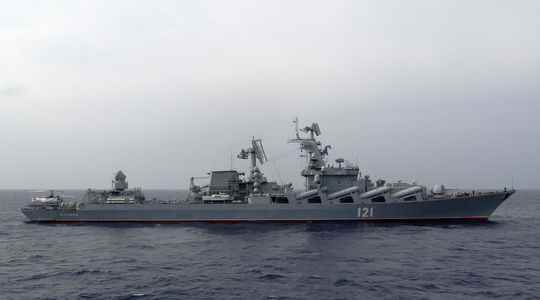The words of the Pentagon resonate as far as the Kremlin: the loss of the cruiser “Moskva” damaged on Wednesday April 13 and sunk on Thursday April 14 is “a heavy blow” for the Russian fleet. The opportunity to highlight the naval aspect of the war since the start of the Russian invasion of Ukraine on February 24. Since the outbreak of the conflict, the fact that the Russian navy is evenly distributed between the Sea of Azov and the sea off Odessa has been a considerable asset for the belligerent.
“There is an absolutely considerable superiority on the part of Russia: 214 ships against 13 for the Ukrainian armed forces”, relates to L’Express Emmanuel Dupuy, president of the Institute Prospective and Security in Europe. Historically, the sea has always occupied a special place in the Russian vision of greatness and Vladimir Putin relies on his naval power to make a name for himself on the geostrategic chessboard. While the Russian army is made up of nearly a million men, between 120,000 and 140,000 soldiers occupy the ranks of the navy.
If the Russians bulge their chests in the waters of the Black Sea, their maritime capacity does not equal that of the Atlantic Alliance. “NATO’s naval superiority is proven because it has 120 surface boats between the Black Sea and the Baltic Sea. On the Russian side, they have 40 boats in the Black Sea, 9 of which have landing capabilities”, explains Emmanuel Dupuy . Take the number of aircraft carriers: the Americans have eleven when the Russians have only one. Regarding the military aircraft belonging to Russia, the specialist draws up a non-exhaustive list: “Moscow has four cruisers, one in each of the fleets, twenty-three frigates, twelve nuclear-powered ballistic missile submarines and twenty-one submarines nuclear attack.”
More generally, the local authorities have for ten years launched a major modernization project. To understand this momentum, we have to go back a few decades. At its height, the Soviet Navy represented a considerable maritime force, numbering around 650 ships in 1990. After the Cold War, it experienced a difficult period marked by the explosion of the Kursk nuclear submarine in 2000, killing all 118 members of crew. To restore the prestige of the Russian fleet, large amounts are injected. “The 2011-2020 armament plan saw the allocation of 25% of the 570 billion euros budgeted for Defense going back to the fleet”, reports Igor Delanoë, deputy director of the Franco-Russian Observatory, in his note. “Russian Navy: strengths and weaknesses of a changing tool”published on March 1, 2018. A figure that is all the higher as the navy is often the poor relation.
The Russian will to modernize its naval fleet
“President Vladimir Putin wanted to modernize his naval forces, in particular by increasing the tonnage and modernizing the armaments on natures”, indicates Emmanuel Dupuy. To mark his ambitions, the Head of State does not hide his love for naval parades. On July 25, 2021, the head of the Kremlin claimed that Russia had earned its place among the “leading world maritime powers.”
In an article titled “the new Russian naval dynamism, a power factor for the Kremlin”, Arnaud Peyronnet, Mediterranean Foundation for Strategic Studies (FMES) associate member of the Strategic Observatory of the Mediterranean and the Middle East (OS2MO) wrote in January 2022: “Russia has been particularly active in recent months, both in its Black Sea stronghold than in the Mediterranean, along the African coast or near the American archipelago of the Hawaiian Islands.” The Kremlin’s objective: to live up to the US Navy and its allies.
For this, the Russian devices had to be modernized. In June 2020, the American business magazine Forbes revealed that Moscow was simultaneously producing six different categories of submarines. Among them is the Kilo-class submersible, which can launch land attack missiles. If the Moscow power tries to dust off its fleet, there is room for improvement: “There are patrol boats, corvettes and frigates, some of which have not been modernized”, adds Emmanuel Dupuy. The specialist also mentions ocean-type boats built with somewhat dated technology – an aluminum hull that has a very low fire resistance. “These are very fragile boats, with less anti-aircraft protection capacity than Western boats,” he says. Another specificity: the Russian ships suffer from a slower modernization concerning radars, surveillance and detection capacity.
Moreover, the annexation of Crimea in March 2014 was also a turning point in the fleet serving the Kremlin. “It had the effect of increasing the number of units assigned to this theater”, explains Pierre Riallant, in these works entitled “Russia is developing a concept of ‘continental naval power'”, published in 2016. The Black Sea has gradually been populated by Russian ships, several of which are equipped with Kalibr missiles with a range of 2,000 kilometers. In his study quoted above, the specialist Igor Delanoë speaks of a “”kalibrization” of the Russian fleet. Note that the cruiser “Moskva” hit by Ukrainian missiles included sixteen Kalibr missiles, which aimed to interrupt or prevent the delivery American equipment delivered to Ukraine.
Moreover, the reinforcement of its fleet in the Black Sea enables Russia to place itself in a position of strength in relation to all of its neighbours. Beyond Ukraine, Romania, Bulgaria and even Georgia have less equipped navies. In addition to the Black Sea, Moscow has established itself in the Mediterranean where it has twenty ships, five of which are equipped with Kalibr. Russia has also strengthened its position on the Syrian coast, particularly in the port of Tartous.
